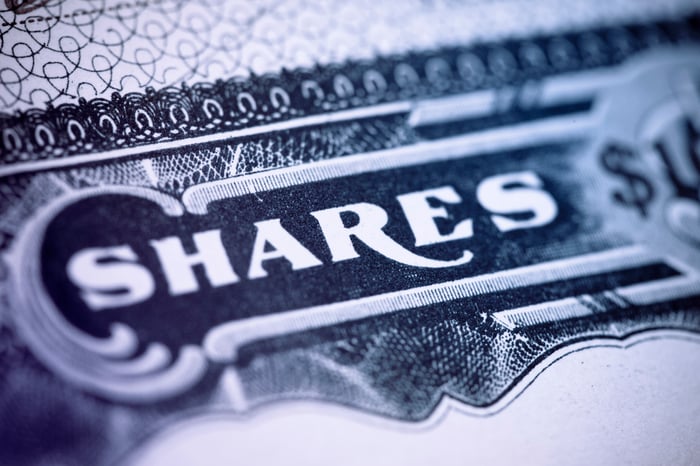Wall Street and the investing community have been taken for a wild ride in 2022. The benchmark S&P 500, which is often Wall Street's favorite barometer of stock market health, turned in its worst first-half return in 52 years. Meanwhile, the technology-dependent Nasdaq Composite has been even worse, with a peak-to-trough decline of as much as 34% since November.
But in spite of this turmoil, investors have been absolutely enamored with the dozens of companies announcing stock splits this year.

Image source: Getty Images.
A stock split allows a publicly traded company to alter its share price and outstanding share count without impacting its market cap or operations. It's the perfect tool for businesses to use to make their shares more affordable for everyday investors who might not otherwise have access to fractional-share purchases through their online brokerages.
Thus far in 2022, a number of exceptionally popular, high-profile stocks have announced and/or enacted stock splits. This includes:
- Amazon (AMZN -1.64%), which declared and enacted a 20-for-1 stock split.
- Shopify (SHOP -2.37%), which announced and moved forward with a 10-for-1 stock split.
- Tesla (TSLA 12.06%), which announced a 3-for-1 split in June and gained approval from its shareholders on August 4 to conduct its split on Aug. 25, 2022.
The $64,000 question is, "Which stock-split stock makes for the better buy right now?"
Is Amazon the perfect stock to add to your shopping cart?
First up is e-commerce giant Amazon, whose share price fell from a peak of $3,700 pre-split to the $140s on a post-split basis. It was the company's first stock split in more than two decades.
When most people hear the word "Amazon," they immediately think of the company's leading online marketplace. This year, Amazon is expected to bring in about $0.40 of every $1 spent in online retail sales in the United States. But this top-tier revenue segment typically generates low operating margins.
The far bigger story for Amazon is what's happening with its higher-margin initiatives, such as subscription services, advertising, and cloud services. For instance, the greater than 200 million people signed up for Prime worldwide bring in tens of billions of dollars in predictable, high-margin revenue for Amazon every year.
Amazon Web Services (AWS) should play an even more important role in growing Amazon's operating cash flow in the years that lie ahead. I say "cash flow" and not earnings given that Amazon loves to reinvest a significant portion of its operating cash flow into its logistics network and various growth initiatives. With AWS accounting for a third of global cloud-service spending in the first quarter, and this segment providing the bulk of Amazon's operating income, it could send Amazon's share price significantly higher.
Should you checkout with Shopify?
Another possibility for investors is to put their money to work in cloud-based e-commerce platform Shopify. After peaking at more than $1,700 prior to its split, shares of this beaten-down tech stock can be had for around $40 on a post-split basis.
What makes Shopify such an intriguing company from the standpoint of long-term investors is its addressable market. A presentation from 2021 estimated that Shopify's e-commerce platform has a $153 billion addressable market just from small businesses (i.e., it's bread-and-butter target). This doesn't even take into account the larger businesses that have begun utilizing Shopify's tools and data analytics. With Shopify on pace to bring in over $7 billion in revenue this year, the implication is that growth is still in the very early innings.
Innovation is another tool that should excite investors. Last year, Shopify launched Shop Pay, its very own buy now, pay later (BNPL) service designed to give merchants and their consumers more payment options. Although BNPL operators have been hammered recently by domestic and global economic weakness, it should ultimately be a positive for Shopify's vast network of merchants over the long run.
Shopify is using bolt-on acquisitions to its advantage, too. Last month, it completed the $2.1 billion cash-and-stock buyout of e-commerce fulfillment company Deliverr. Buying Deliverr further compliments Shopify's Fulfillment Network and should give merchants more peace of mind when managing their inventory and direct-to-consumer sales.
Can investors burn rubber with Tesla?
The third potential stock-split stock to buy is electric-vehicle (EV) manufacturer Tesla. The company's upcoming split will mark its second in two years.
The reason investors gravitate to Tesla is because of the company's competitive advantages. It's the first automaker to build itself from the ground up to mass production in more than five decades. Even with semiconductor chip shortages hurting production, and the company's Shanghai gigafactory being adversely impacted by COVID-19 lockdowns, Tesla looks to be well on its way to surpassing 1 million EV deliveries in a year for the first time.
In addition to production, Tesla has turned the corner to recurring profitability. Whereas the company had relied heavily on selling renewable energy credits (RECs) to other automakers prior to 2020, it's been generating generally accepted accounting principles (GAAP) profits without the need for RECs to push it to a sizable profit. In each of the past five quarters, Tesla has delivered a GAAP profit ranging from $1.14 billion to $3.32 billion.
Tesla's success is also a reflection of investors' belief in CEO Elon Musk as an innovator. As CEO, Musk has helped diversify his company's operations -- e.g., Tesla provides energy storage systems and installs solar panels via subsidiaries -- and has kept the company's user base excited about upcoming innovations, such as Tesla Bot, a robotic humanoid that could serve a variety of purposes.

Image source: Getty Images.
The better stock-split stock to buy right now is...
Ultimately, Amazon, Shopify, and Tesla wouldn't have announced stock splits if their respective share prices hadn't significantly risen following great execution. But only one of these three stock-split stocks stands out as the clear better buy right now.
In my view, it's certainly not Tesla. The biggest issue with Tesla just might be Elon Musk. Aside from drawing the ire of the Securities and Exchange Commission on multiple occasions, Musk has continually overpromised and underdelivered as CEO. While the company's share price would say others, we've seen delays to practically every major project or innovation proposed by Musk, including robotaxis and the Cybertruck, among others.
Tesla is also quite expensive. Whereas most auto stocks trade at single-digit forward price-to-earnings (P/E) ratios, Tesla will have investors paying about 54 times Wall Street's forecast earnings in 2023 for a company that'll likely see its competitive advantages wane over time.
Despite it being a popular buy right now, I don't believe Shopify is the answer, either. This is a retail-driven company that's susceptible to slower growth from rapidly rising interest rates and contracting U.S. gross domestic product. While there's no question Shopify has a delectably large addressable market, the company has a lot of work to do on its bottom-line to attract long-term investors.
The stock-split stock that's the absolute best buy of the three right now is Amazon.
Although its P/E ratio is an eye-popper for all the wrong reasons, the P/E ratio is a poor way to measure value with Amazon. As noted, because Amazon reinvests most of its operating cash flow back into its business, price-to-cash-flow is a far better measure of value.
Between 2010 and 2019, investors paid a year-end multiple of 23 to 37 times year-end cash flow. Based on Wall Street's 2025 forecast, which takes into account AWS growing into a larger percentage of total sales, Amazon is valued at just 10 times cash flow. If Amazon hits this estimate, it would be the cheapest shares have ever been. Valuation and innovation give Amazon the clear edge over Shopify and Tesla right now.





